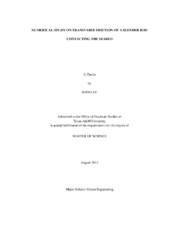| dc.description.abstract | With the increasing developments of exploiting oil and natural gas in deep water and harnessing renewable (wave and wind) energy in the sea, mooring lines and risers are widely deployed to position the related floating structures. Subject to environmental loads, a mooring line or riser connected to floating structure, moves up and down, back and forth, and sometimes from the left to the right. In computation of the dynamics of a mooring line or riser, it is often modeled as a flexible slender rod. While the bending moment of a chain or a rope is neglected, that of a riser is considered and specified by characteristics of the riser. Existing numerical codes for simulating the dynamics of a slender rod, such as CABLE3D, allow for the vertical support force and longitudinal (along the direction of the rod) friction from soils of the seabed while the transverse (in the direction transverse to the slender rod) friction between the rod and the seabed soils is not considered. In this study, we extend the current version of CABLE3D to allow for the transverse friction applied on the portion of a slender rod contacting the seabed soil, which is time-varying when it is moving. The friction between a slender rod and the seabed soil is computed based upon a Coulomb model originally developed for the simulation of the friction in all dry contact mechanical systems. In applying the Coulomb model, the transverse friction depends on the transverse displacement and/or velocity of a slender rod contacting the seabed. In addition, vertical bottom support of the seabed soil is calculated based on the shear stress of the seabed soil. The simulations of the dynamics of a few typical mooring lines are made given their motions at their fairleads and the results are compared with the corresponding results obtained using Orcaflex, a commercial code, and the existing version of CABLE3D. | en |


